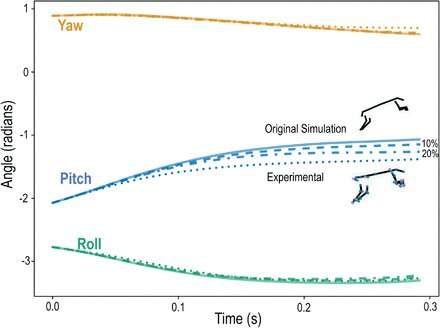Extensive testing shows dogs’ tails are not used for stabilization

A team of researchers from the Max Planck Institute for Intelligent Systems, Friedrich-Schiller-University, and the Georgia Institute of Technology has found that contrary to prior research results, dogs do not use their tails to help stabilize their movements. Instead, as they explain in their paper posted on the arXiv preprint, the tails are used as a communications device.
In a decade-long study, the researchers analyzed the movements of several border collies fitted with a special suit that held tracking beads. They also used software to process missing marker data that allowed for smoothing splines that were fitted over real data.
The researchers began their work by noting that members of Canidae are unique among mammalian carnivores because they do not climb trees. Thus, their tails are not needed to help them survive in such an environment. They then noted that many other ground animals with tails use them for stabilization during running or jumping. Cheetahs, for example, use their tails to help them remain stable as the run very fast. Dogs’ tails, the researchers noted, are smaller than those of tree-dwelling creatures and much less agile than those found on creatures such as cats, which use them quite extensively to keep their balance.

To learn whether dogs’ tails help stabilize their movements, the researchers fitted multiple border collies with suits with sewn-in sensor beads that allowed for noting on a computer the movement of every part of the body during running, jumping and other activities. Additional software helped with modeling and mapping. This allowed the researchers to have the virtual dogs conduct the same sorts of activities as the real dogs. It also allowed for removal of the tails from the virtual dogs.
Doing so showed very little difference in abilities. Overall, the researchers found that the dogs did not use their tails to help them keep their balance or to change direction, or for anything else, at least physically. They note that prior research has shown that dogs use their tails to convey their mood and intentions. Fast wagging, for example, usually means the dog is happy. They suggest that while the tails of dogs may have once served a larger purpose, those that live in modern times appear to only use them to show others around them how they are feeling—a very useful ability for a pack animal.
More information:
Tom Rottier et al, Tail wags the dog is unsupported by biomechanical Modeling of Canidae Tails Use during Terrestrial Motion, bioRxiv (2022). DOI: 10.1101/2022.12.30.522334
© 2023 Science X Network
Citation:
Extensive testing shows dogs’ tails are not used for stabilization (2023, January 4)
retrieved 5 January 2023
from https://phys.org/news/2023-01-extensive-dogs-tails-stabilization.html
This document is subject to copyright. Apart from any fair dealing for the purpose of private study or research, no
part may be reproduced without the written permission. The content is provided for information purposes only.
For all the latest Science News Click Here
For the latest news and updates, follow us on Google News.

